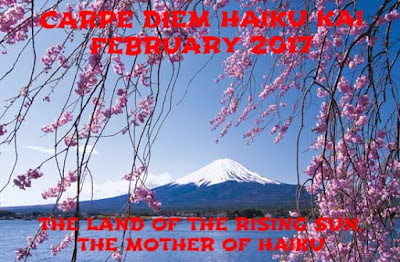Dear Haijin, visitors and travelers,
It is my pleasure to announce that Chèvrefeuille's Publications has created a new exclusive CDHK e-book "Only Footprints" by Candy. Candy was the winner of our 'tribute to Jane' kukai and won the opportunity to create an e-book.
The download link isn't ready now, but that will change later today.
Today we are going further on our journey through Japan, the "Motherland" of Haiku. Today I love to tell you all a little bit more about Ise Shrine. Ise Shrine is one of the most famous shrines of Japan and you sure will remember several haiku poets, e.g. Issa and Basho, which have written haiku in praise of Ise Shrine.
 |
| Ise Shrine |
The Inner
Shrine, Naikū (also officially known as "Kotai Jingū"), is located in
the town of Uji-tachi, south of central Ise, and is dedicated to the worship of
Amaterasu, where she is believed to dwell. The shrine buildings are made of
solid cypress wood and use no nails but instead joined wood. The Outer Shrine,
Gekū (also officially known as "Toyouke Daijingū"), is located about
six kilometers from Naikū and dedicated to Toyouke-Ōmikami, the god of
agriculture, rice harvest and industry. Besides Naikū and Gekū, there are an
additional 123 Shinto shrines in Ise City and the surrounding areas, 91 of them
connected to Naikū and 32 to Gekū.
During the
Edo period, it is estimated that one out of ten Japanese conducted an Okage
Mai-Ri pilgrimage to the shrine. Accordingly, pilgrimage to the shrine
flourished in both commercial and religious frequency. Because the shrine is
considered sanctuary, no security checkpoints were conducted, as it was
considered sacrilege by the faithful. The two main shrines of Ise are joined by
a pilgrimage road that passes through the old entertainment district of
Furuichi.
The chief
priest or priestess of Ise Shrine must come from the Imperial House of Japan
and is responsible for watching over the Shrine. The current high priestess of
the shrine is Atsuko Ikeda, assisted by former imperial princess Sayako Kuroda.
 |
| Yamatohime-no-mikoto |
According
to the Nihon Shoki, around 2000 years ago the divine Yamatohime-no-mikoto,
daughter of the Emperor Suinin, set out from Mt. Miwa in modern Nara Prefecture
in search of a permanent location to worship the goddess Amaterasu, wandering
for 20 years through the regions of Ohmi and Mino. Her search eventually
brought her to Ise, in modern Mie Prefecture, where she is said to have
established Naikū after hearing the voice of Amaterasu saying "(Ise) is a
secluded and pleasant land. In this land I wish to dwell." Before
Yamatohime-no-mikoto's journey, Amaterasu had been worshiped at the imperial
residence in Yamato, then briefly at Kasanui in the eastern Nara basin. When
Princess Yamatohime-no-mikoto arrived at the village of Uji-tachi, she set up
fifty bells to designate the area as enshrined for the goddess Amaterasu, which
is why the river is called the Isuzu, or "fifty bells".
I ran into a few haiku by Basho about Ise Shrine, he has also made a journey to the Grand Shrine of Ise and (maybe) wrote these haiku:
For
holiness,
Everyone has pushed others in the crowd.
The Shrine Removal !
in Ise's shrine cemetery
even more lonely
the moon still is
© Matsuo BashoEveryone has pushed others in the crowd.
The Shrine Removal !
in Ise's shrine cemetery
even more lonely
the moon still is
The Grand Shrine of Ise is the most important shrine of Shinto, so therefore I will "dive into" Shinto tomorrow.
This episode is NOW OPEN for your submissions and will remain open until February 12th at noon (CET). I will try to publish our new episode, Shinto, later on.

No comments:
Post a Comment